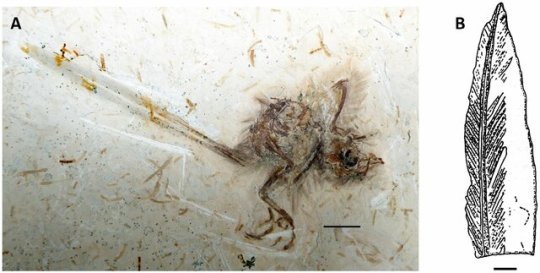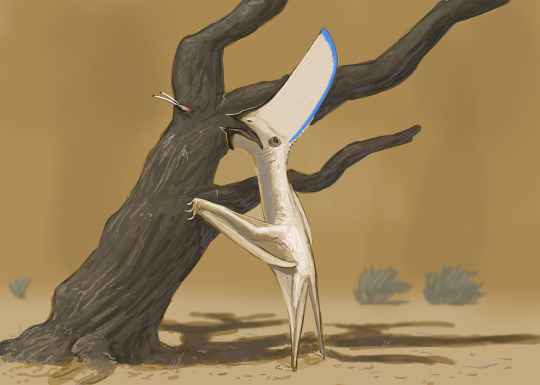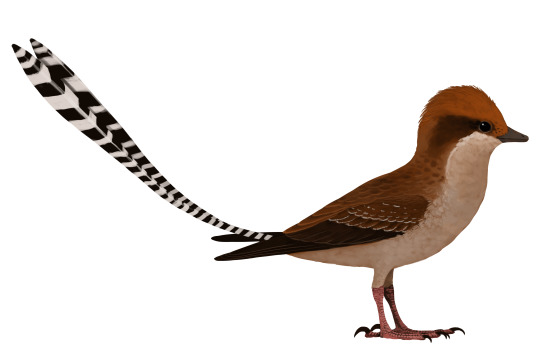#Cratoavis
Note
Pleeeeease add Cratoavis on your list of fossils with feathers, Cratoavis deserves more love, they smol <3 (there are too many to add okay but... but... Cratoavis... I don't have a justification here. Just <3)

Look at the little friend!!!
59 notes
·
View notes
Text

Another sketch brought to you by #paleostream
Tupandactylus navigans inspecting a small bird, Cratoavis.
1K notes
·
View notes
Text
Cratonavis zhui Li et al., 2023 (new genus and species)

(Type specimen of Cratonavis zhui with select skeletal regions highlighted [scale bars = 10 mm], from Li et al., 2023)
Meaning of name: Cratonavis = craton [in English, referring to the destruction of the North China Craton during the Early Cretaceous] bird [in Latin]; zhui = for Zhu Rixiang [Chinese geologist]
Age: Early Cretaceous (Aptian), about 119 million years ago
Where found: Jiufotang Formation, Liaoning, China
How much is known: Nearly complete skeleton of one individual with preserved feathers.
Notes: Cratonavis was an early avialan, a group of mostly flight-capable dinosaurs that also contains modern birds. It appears to have been closely related to Jinguofortis and Chongmingia, two other avialans known from the Early Cretaceous of China. Their lineage shared with modern birds a short tail and reduced fingers, but were more similar to non-avialan theropods in the structure of their skull and shoulder girdle.
Among Mesozoic avialans, Cratonavis was unusual in having a particularly long shoulder blade. It also had a long, backwards-facing innermost toe on each foot, which may have been an adaptation to perching or grasping.
Cratonavis is not to be confused with Cratoavis, an enantiornithean avialan from the Early Cretaceous of Brazil.
Reference: Li, Z., M. Wang, T.A. Stidham, and Z. Zhou. 2023. Decoupling the skull and skeleton in a Cretaceous bird with unique appendicular morphologies. Nature Ecology and Evolution advance online publication. doi: 10.1038/s41559-022-01921-w
100 notes
·
View notes
Photo

cratoavis, a tiny bird only about 6-7cm in length from early cretaceous brazil
676 notes
·
View notes
Photo

(Note: I am not a professional paleontologist or even biologist. I am just and amateur paleoartist and enthusiast. If my infos are off in some way, feel free to correct them ^^)
-
DINOCEMBER
11 - Ubirajara jubatus (from Tupi “lord of the spears”)
- Early Cretaceous (110 Ma BCE)
- Crato Formation, Ceará, Brazil
Named at the end of 2020, Ubirajara is one of the most impressive fossils found in Brazilian territory, being a member of the Compsognathidae, small theropods covered with proto-feathers - or "dino-fuzz" - related to raptors and tyrannosaurs, whose most famous members are China's Sinosauropteryx and Germany's Compsognathus itself. Described from a partial skeleton without the skull, Ubirajara presents impressions of its fuzz, having an apparent "mane" in its dorsal region and pairs of quills on its shoulders, similar to what is found in the current birds-of-paradise, probably used in courtship or to intimidate rivals.
The Crato Formation, as well as most of the formations in the Araripe Basin, would be the margins of a large saltwater lagoon, as well as a system of rivers surrounded by gymnosperms and some of the first flowering plants, being rich in fossil extract, especially of pterosaurs, and some curious animals, like the Enantiornithe Cratoavis. Unfortunately, Ubirajara, like other Brazilian fossils, is a target of international fossil trafficking, not having a single native author in the paper that describes it, with the team led by David Martill, a German paleontologist who smugled the Ubirajara fossil to Germany in 1995, and he cannot set foot on Brazilian territory for this and other crimes. Since its description, Ubirajara has been the target of campaigns for its repatriation, as well as other national fossils. I use this drawing as my collaboration for the campaign, and that so that this colonialist and criminal mentality ceases to exist in the paleontological community.
- Ubirajara’s color scheme inspired by a Vinaceous-breasted Amazon (Amazona vinacea) and a Vulturine Parrot (Pyrilia vulturina) and Cratoavis’ colors isnpired by a Black-thorated trogon (Trogon rufus). All of them are Brazilian birds
#UbirajaraBelongstoBR#ubirajara jubatus#ubirajara#theropod#compsognathus#compsognathidae#coelurosauria#feathered dinosaurs#Brazil#brazilian dinosaurs#dinocember2020#dinovember#Cratoavis#Crato Formation#Araripe Basin#creature design#creature art#creature concept#dinosaur#paleobiology#paleontology#paleoart#paleoillustration#sciart#science illustration
7 notes
·
View notes
Photo

UbirajaraBelongsToBR
Finally had a chance to draw Ubirajara jubatus! Let's repatriate this beautiful fossil and decolonize paleontology to give voice to Global South scientists!
ID: Drawing of a green and yellow Ubirajara jubatus, a fluffy dinossaur with four long feathers in shoulders, jumping with irritaded expression. Over them is the hashtag "UbirajaraBelongsToBR". The background is purple is starry, the frame is blue. Around them is a little flying paleobird called Cratoavis, a gas canister decorated with crochet, a brown ceramic water filter, and a caramel puppy. End ID.
🌟 Commission prices and terms of service @ my Carrd! (March/April 2022)
.
.
.
🌟 Where to find me:
deviantArt | FurAffinity | Telegram channel | Tumblr | Twitter
#groundpear#furry#furryart#furry art#azpainter3#dinosaur#paleoart#palaeoart#ubirajara#ubirajarajubatus#ubirajarabelongstobr#my art
3 notes
·
View notes
Photo

Ave mais antiga do Brasil, descoberta em Nova Olinda, esteve no desfile da União da Ilha. A Cratoavis cearensis foi descoberta na formação sedimentar Santana, membro Crato, e descrita em 2015. http://bit.ly/2XHM5Sk ≣≣≣≣≣≣≣≣≣≣≣≣≣≣≣≣≣≣≣≣≣≣≣≣≣≣ ⠀⠀⠀ ⏫ Leia Essa Matéria no Stories 📌 Ou Acessem: F5cariri.com ⠀ ⠀⠀⠀⠀⠀⠀ ılı.lıllılı.ıllı..ılı.lıllılı.ıllıılı.lıllılı.ıllı..ılı.lıllılı.ıllı #Padrecicero #Crato #Carri #Festadesantoantonio #Edocariri #Romeiros #Caririgardenshopping #Crajubar #Milagres #Missãovelha #Fortaleza # #capitaldafe #juazeirodonorte #Barbalha #terradopadrecicero #clicandoobrasil #melhor_brasil_ #great_captures_brasil #mostreseuclick #brazilsuperphotos #tbt #Política #Brasil #Notícia ılı.lıllılı.ıllı..ılı.lıllılı.ıllıılı.lıllılı.ıllı..ılı.lıllılı.ıllı 🔹Use #f5cariri e venha fazer parte da nossa história. ━━━━━━━━━━━━━━━━━━ https://www.instagram.com/p/Burcc_EnOrQ/?utm_source=ig_tumblr_share&igshid=1ilx9g3djn5ao
#padrecicero#crato#carri#festadesantoantonio#edocariri#romeiros#caririgardenshopping#crajubar#milagres#missãovelha#fortaleza#capitaldafe#juazeirodonorte#barbalha#terradopadrecicero#clicandoobrasil#melhor_brasil_#great_captures_brasil#mostreseuclick#brazilsuperphotos#tbt#política#brasil#notícia#f5cariri
0 notes
Photo

I found an official inktober prompt list, but I’m going to ignore it unless I feel like doing otherwise.
Reading up on what lived in the same era/region as Tapejara and found out that Araripesuchus wegeneri is now thought to be an omnivore! So here are some Brazilian archosaurs squabbling over juniper berries.
I’d like to make this scene since I’ve got a Tapajara in progress anyway, but the resin cost for all those rocks and a diplodocid rib is a little intimidating...
#inktober#my art#tapejara#araripesuchus#cratoavis#if I do make it it'll be a wall hanging piece around 4 feet high
24 notes
·
View notes
Text
yes, I know I'm only listing a few things per ecosystem, these polls have character limits
polls can only have ten options. I did my best. I even made a sacrifice - my favorite dinosaur, Maiasaura, is from Two Medicine, which I did not include, because its very similar to Hell Creek. So.
445 notes
·
View notes
Text
Cratoavis cearensis

By Jack Wood on @thewoodparable
PLEASE SUPPORT US ON PATREON. EACH and EVERY DONATION helps to keep this blog running! Any amount, even ONE DOLLAR is APPRECIATED! IF YOU ENJOY THIS CONTENT, please CONSIDER DONATING!
Name: Cratoavis cearensis
Name Meaning: Crato Bird
First Described: 2015
Described By: Carvalho et al.
Classification: Dinosauria, Theropoda, Neotheropoda, Averostra, Tetanurae, Orionides, Avetheropoda, Coelurosauria, Tyrannoraptora, Maniraptoriformes, Maniraptora, Pennaraptora, Paraves, Eumaniraptora, Averaptora, Avialae, Euavialae, Avebrevicauda, Pygostylia, Ornithothoraces, Enantiornithes
Cratoavis is a recently described Oposite Bird from the Santana Formation of Brazil, living in the Aptian age of the Early Cretaceous, sometime between 125 and 113 million years ago. It is known from a nearly complete skeleton preserved on a slab, which also preserves some feathering. It was a small animal and probably was a juvenile, though fuzed bones throw that into some question and it’s difficult to exactly determine the age of Cratoavis. It also had a pair of ribbon like feathers extending from the tail like many other Opposite Birds. It had long, gracile hands, and a gracile coracoid, indicating that it had long wings that were perhaps not built for robust flapping like in other birds. However, this gracile state is found elsewhere in the skeleton of Cratoavis and may just be due to its possible juvenile state.
Source:
Carvalho, I. d. S., F. E. Novas, F. L. Agnolín, M. P. Isasi, F. I. Freitas, J. A. Andrade. 2015. A new genus and species of enantiornithine bird from the Early Cretaceous of Brazil. Brazilian Journal of Geology 45 (2): 161 - 171.
Shout out goes to @chaos-lionheart!
#cratoavis#cratoavis cearensis#bird#dinosaur#palaeoblr#birblr#chaos-lionheart#paleontology#prehistory#prehistoric life#dinosaurs#biology#a dinosaur a day#a-dinosaur-a-day#dinosaur of the day#dinosaur-of-the-day#science#nature#factfile#Dìneasar#דינוזאור#डायनासोर#ديناصور#ডাইনোসর#risaeðla#ڈایناسور#deinosor#恐龍#恐龙#динозавр
36 notes
·
View notes